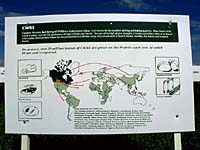
There are several economic terms frequently used in discussions about the marketing of agricultural products.
Supply is the quantity of a product or service that sellers are willing to provide to the market at a given price. When prices are high,
sellers are willing to provide larger quantities of their products
to the market than when prices are low.
Demand is
the quantity of a product or service buyers are willing to purchase
from the market at a given price. When prices are low, buyers
are willing to purchase greater quantities of a product than when
prices are high. There is a direct relationship between product
supply and product demand.
Economic factors are
influences such as changes in supply and demand, inflation or
deflation, technological advances, tariffs and world situations
that affect the price received by the producer or user of the
agricultural commodity.
Domestic market refers
to markets within Canada. This market may include processing companies,
the Canadian food industry and individual producers.
International market refers
to the customers outside of Canada who purchase Canadian products.
General Agreement on Tariffs and
Trade (GATT) is the agreement
established shortly after World War II that provides guidelines
for trading accessibility to all countries. Today, over 100 countries
are involved in GATT.
Canada United States Trade Agreement (CUSTA)
is the bilateral freer trade policy established in 1989 between
Canada and the United States.
Canadian Wheat Board is
a government agency established to market western Canadian wheat
and barley for export or for human consumption in Canada. It may
also sell feed grains for animal consumption in Canada.
[More on Wheat Board]
Open market is
the market used by producers for any grain marketing transactions
not handled by the Canadian Wheat Board. It is used by producers
of rye, flaxseed, canola and other specialty crops. Producers
sell their crops directly to the local grain elevators or primary
elevators for a price determined by larger grain companies using
the market quotations from grain trading facilities such as the
Winnipeg Commodity Exchange.
[More on Open Market]
Winnipeg Commodity Exchange facilitates
the buying and selling of grain. It does not handle grain nor
is it directly engaged in the purchase or sale of a commodity.
It provides a cash and a futures market for each commodity traded.
The futures market provides the opportunity for buyers and sellers
of grain to negotiate what the crops will be valued at in future
months by considering world supply and demand factors.
[More on Winnipeg Commodity Exchange]
Input or production costs are
costs incurred by the farmer or rancher in growing or raising
produce. They refer to expenses such as cost of seed, fuel, fertilizer
and chemicals, replacement of machinery and pasture fees.
Marketing agricultural products consists
of two sectors: marketing primary production and marketing processed
products. Successful marketing in both areas depends directly
on consumer demands.
Farmers and ranchers market the products
they produce through a variety of means. They can sell to the
consumer directly, through government agencies or on the open
market. Processed products are generally marketed through retail
stores or food service industries.
The Value of the Canadian Dollar
Every day, during discussions of
issues in agriculture and in other areas, the value of the Canadian
dollar is referred to on the news or in newspapers and magazine
articles. The value of the Canadian dollar fluctuates daily and
is influenced by interest rates, politics and the rate of inflation.
Because Canada's largest trading partner is the United States,
our dollar is often compared to the dollar of that country.
The kind and value of money
varies according to the country using it. For example, the peso,
lire, franc and English pound all have different values
when compared to the money of another country. That value is usually
compared to the value of the money of the largest trading countries
of the world and is determined by international economists and
money traders.
Anything produced in Canada, whether
it is an agricultural product or a manufactured item, is produced
for sale. Many of these products are exported to the international
market. This is like selling the product in a huge international
grocery store. When our dollar is lower in value than the dollar
of the country purchasing our products, the purchasing country
can buy more products for fewer dollars.
When it is reported that the value
of the Canadian dollar has dropped in relation to the United States
dollar, it is often assumed
that this occurrence is not good for Canada. This is not always
the case. If the value of the Canadian dollar decreases
in relation to the United States dollar, countries will be able
to purchase larger amounts of Canadian agricultural commodities.
Grain and Oilseed Marketing
Grain and oilseeds are sold to markets
around the world and in Canada through the Canadian Wheat Board
or on the open market, depending on the type of crop being marketed.
Prairie grown wheat and barley must be marketed through the Canadian
Wheat Board if they are being sold for export or human consumption
in Canada. They may also be marketed through the Wheat Board if
they are being sold in Canada for livestock feed. All other crops
grown in Saskatchewan are sold on the open market.
| 